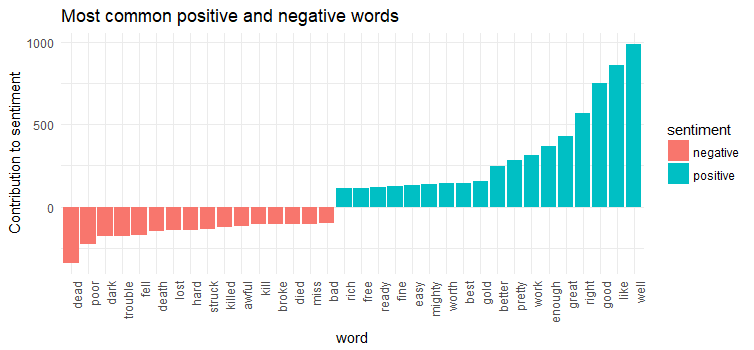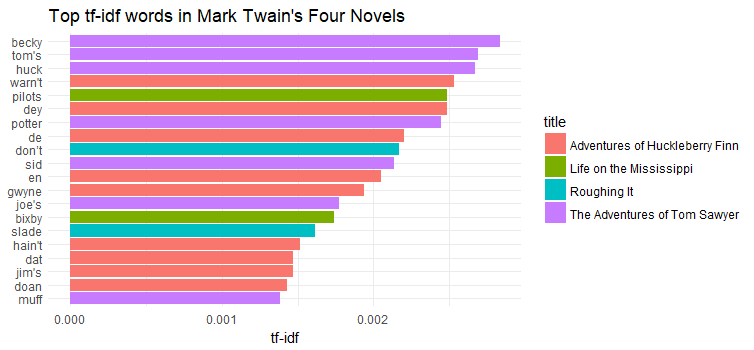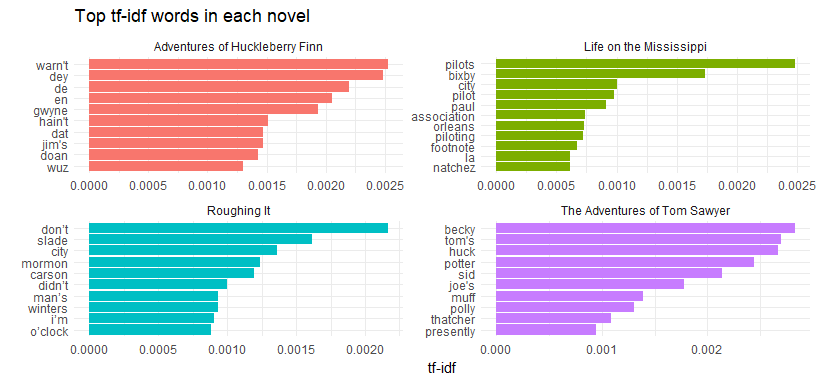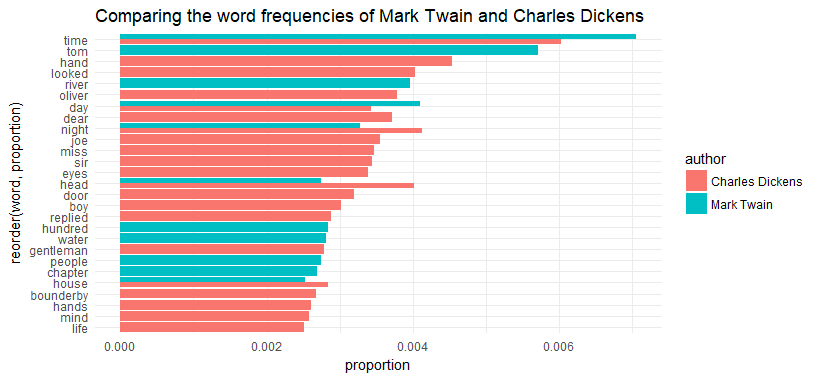Introduction
Samuel Langhorne Clemens, otherwise known as Mark Twain, is one of the most important American writers.”The Adventures of Tom Sawyer” is probably one of my most favorite books in all English literature. Happy to see that Twain’s river novels remain required reading for young students, he is read more widely now than ever!
Project Gutenberg offers over 53,000 free books. I will use four of Twain’s best novels for this analysis:
- Roughing It
- Life on the Mississippi
- The Adventures of Tom Sawyer
- Adventures of Huckleberry Finn
We will be using the following packages for the analysis:
library(tidyverse)
library(tidyr)
library(ggplot2)
library(tidytext)
library(stringr)
library(dplyr)
library(tm)
library(topicmodels)
library(gutenbergr)
theme_set(theme_minimal())Data preprocessing
We’ll retrieve these four books using the gutenbergr package:
books <- gutenberg_download(c(3177, 245, 74, 76), meta_fields = "title")An important preprocessing step is tokenization. This is the process of splitting a text into individual words or sequences of words. The unnest_tokens function is a way to do just that. The result is converting the text column to be one-token-per-row like so:
tidy_books <- books %>%
unnest_tokens(word, text)
tidy_books### A tibble: 502,799 x 3
## gutenberg_id title word
## <int> <chr> <chr>
## 1 74 The Adventures of Tom Sawyer the
## 2 74 The Adventures of Tom Sawyer adventures
## 3 74 The Adventures of Tom Sawyer of
## 4 74 The Adventures of Tom Sawyer tom
## 5 74 The Adventures of Tom Sawyer sawyer
## 6 74 The Adventures of Tom Sawyer by
## 7 74 The Adventures of Tom Sawyer mark
## 8 74 The Adventures of Tom Sawyer twain
## 9 74 The Adventures of Tom Sawyer samuel
##10 74 The Adventures of Tom Sawyer langhorne
# ... with 502,789 more rowsAfter removing stop words, we can find the most common words in all the four books as a whole.
data("stop_words")
cleaned_books <- tidy_books %>%
anti_join(stop_words)
cleaned_books %>%
count(word, sort = TRUE)### A tibble: 21,630 x 2
## word n
## <chr> <int>
## 1 time 1215
## 2 tom 982
## 3 day 701
## 4 river 684
## 5 night 562
## 6 hundred 490
## 7 water 483
## 8 head 471
## 9 chapter 465
##10 people 461
# ... with 21,620 more rowsSentiment
Sentiment analysis is not the focus today, but since we are here already, why not have a quick look?
bing <- get_sentiments("bing")
bing_word_counts <- tidy_books %>%
inner_join(bing) %>%
count(word, sentiment, sort = TRUE) %>%
ungroup()
bing_word_counts### A tibble: 3,023 x 3
## word sentiment n
## <chr> <chr> <int>
## 1 well positive 989
## 2 like positive 856
## 3 good positive 751
## 4 right positive 566
## 5 great positive 427
## 6 enough positive 367
## 7 dead negative 344
## 8 work positive 311
## 9 pretty positive 280
##10 better positive 244
# ... with 3,013 more rowsbing_word_counts %>%
filter(n > 100) %>%
mutate(n = ifelse(sentiment == 'negative', -n, n)) %>%
mutate(word = reorder(word, n)) %>%
ggplot(aes(word, n, fill = sentiment)) +
geom_bar(stat = 'identity') +
theme(axis.text.x = element_text(angle = 90, hjust = 1)) +
ylab('Contribution to sentiment') + ggtitle('Most common positive and negative words')
We did not spot anomaly in the sentiment analysis results except word “miss’ is identified as a negative word, actually, it is used as a title for the tough old spinster Miss Watson in “Adventures of Huckleberry Finn”.
tf-idf
To blatantly quote the Wikipedia article on tf-idf:
In text analysis, tf-idf, short for term frequency–inverse document frequency, is a numerical statistic that is intended to reflect how important a word is to a document in a collection or corpus. It is often used as a weighting factor in information retrieval and text mining.
For our purpose, we want to know the most important words(highest tf-idf) in Mark Twain’s four books overall, and most important words(highest tf-idf) in each of these four books. Let’s find out.
book_words <- cleaned_books %>%
count(title, word, sort = TRUE) %>%
ungroup()
total_words <- book_words %>%
group_by(title) %>%
summarize(total = sum(n))
book_words <- left_join(book_words, total_words)
book_words### A tibble: 38,346 x 4
## title word n total
## <chr> <chr> <int> <int>
## 1 The Adventures of Tom Sawyer tom 722 24977
## 2 Life on the Mississippi river 486 51875
## 3 Life on the Mississippi time 355 51875
## 4 Adventures of Huckleberry Finn jim 351 32959
## 5 Roughing It time 344 62611
## 6 Adventures of Huckleberry Finn time 325 32959
## 7 Roughing It day 300 62611
## 8 Adventures of Huckleberry Finn warn't 290 32959
## 9 Adventures of Huckleberry Finn de 252 32959
##10 Life on the Mississippi water 245 51875
# ... with 38,336 more rowsTerms with the highest tf-idf across all the four novels
book_words <- book_words %>%
bind_tf_idf(word, title, n)
book_words %>%
select(-total) %>%
arrange(desc(tf_idf))### A tibble: 38,346 x 6
## title word n tf idf tf_idf
## <chr> <chr> <int> <dbl> <dbl> ##<dbl>
## 1 The Adventures of Tom Sawyer becky 102 0.004083757 0.6931472 0.002830645
## 2 The Adventures of Tom Sawyer tom's 97 0.003883573 0.6931472 0.002691888
## 3 The Adventures of Tom Sawyer huck 232 0.009288545 0.2876821 0.002672148
## 4 AdventuresofHuckleberry Finn warn't290 0.008798811 0.2876821 0.002531260
## 5 Life on the Mississippi pilots 93 0.001792771 1.3862944 0.002485308
## 6 AdventuresofHuckleberry Finn dey 59 0.001790103 1.3862944 0.002481609
## 7 The Adventures of Tom Sawyer potter 44 0.001761621 1.3862944 0.002442125
## 8 AdventuresofHuckleberry Finn de 252 0.007645863 0.2876821 0.002199578
## 9 Roughing It don’t 98 0.001565220 1.3862944 0.00216985
##10 The Adventures of Tom Sawyer sid 77 0.003082836 0.6931472 0.002136859
### ... with 38,336 more rowsplot <- book_words %>%
arrange(desc(tf_idf)) %>%
mutate(word = factor(word, levels = rev(unique(word))))
plot %>%
top_n(20) %>%
ggplot(aes(word, tf_idf, fill = title)) +
geom_bar(stat = 'identity', position = position_dodge())+
labs(x = NULL, y = "tf-idf") +
coord_flip() + ggtitle("Top tf-idf words in Mark Twain's Four Novels")
plot %>%
group_by(title) %>%
top_n(10) %>%
ungroup %>%
ggplot(aes(word, tf_idf, fill = title)) +
geom_col(show.legend = FALSE) +
labs(x = NULL, y = "tf-idf") +
facet_wrap(~title, ncol = 2, scales = "free") +
coord_flip() + ggtitle('Top tf-idf words in each novel')
Each novel has its own highest tf-idf words. However, the language he used across these four novels are pretty similar, such as term “city” has high tf-idf in “Roughing it” and “Life on the Mississippi”.
Term frequency
Just for the kicks, let’s compare Mark Twain’s works with those of Charles Dicken’s. Let’s get “A Tale of Two Cities”, “Great Expectations”, “A Christmas Carol in Prose; Being a Ghost Story of Christmas”, “Oliver Twist” and “Hard Times”.
What are the most common words in these novels of Charles Dickens?
dickens <- gutenberg_download(c(98, 1400, 46, 730, 786))
tidy_dickens <- dickens %>%
unnest_tokens(word, text) %>%
anti_join(stop_words)
tidy_dickens %>%
count(word, sort = TRUE)### A tibble: 19,634 x 2
## word n
## <chr> <int>
## 1 time 1218
## 2 hand 918
## 3 night 835
## 4 looked 814
## 5 head 813
## 6 oliver 766
## 7 dear 751
## 8 joe 718
## 9 miss 702
##10 sir 697
### ... with 19,624 more rowstidy_twains <- books %>%
unnest_tokens(word, text) %>%
anti_join(stop_words)
frequency <- bind_rows(mutate(tidy_twains, author = "Mark Twain"),
mutate(tidy_dickens, author = "Charles Dickens")) %>%
mutate(word = str_extract(word, "[a-z']+")) %>%
count(author, word) %>%
group_by(author) %>%
mutate(proportion = n / sum(n)) %>%
select(-n) %>%
spread(author, proportion) %>%
gather(author, proportion, `Mark Twain`:`Charles Dickens`)
frequency$word <- factor(frequency$word,
levels=unique(with(frequency,
word[order(proportion, word,
decreasing = TRUE)])))
frequency <- frequency[complete.cases(frequency), ]
ggplot(aes(x = reorder(word, proportion), y = proportion, fill = author),
data = subset(frequency, proportion>0.0025)) +
geom_bar(stat = 'identity', position = position_dodge())+
coord_flip() + ggtitle('Comparing the word frequencies of Mark Twain and Charles Dickens')
The top term for both author is the same - “time”. Other than that, their language are very different.
